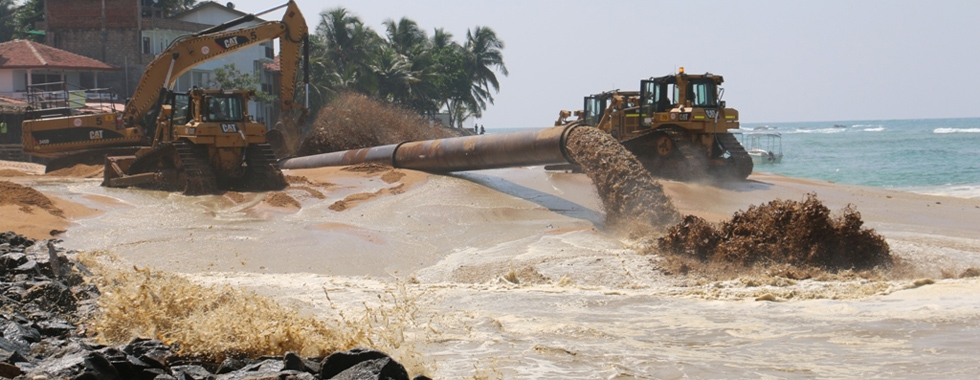Sunday Times 2
Unawatuna Beach: Has the nation got it back?
March 18, 2015, a truly momentous day in the history of Unawatuna. After a year of preparation, the Coast Conservation Department, true to their word, have started pumping sand onto the eroded eastern and middle section of Unawatuna Beach.
The previous day, a huge ship arrived in the bay, loaded with sand. The metre-wide chain of pipes that have been floating, partially submerged in the ocean, were connected to the ship and sand was pumped from the vessel via the pipes to the shoreline. Around 9 a.m. on March 18, the articulated arm of a bulldozer swung into action and lifted the final pipe into position and a great gush of sand spewed onto the shoreline, covering the rocks and filling the sea shore with sand. Three bulldozers then began the process of spreading the sand; carpeting an area 35 metres in length from the sea to the eroded coast line.
This process continued through the morning, punctuated with purges of sand from the carefully positioned pipe. By mid-day the ship had relieved itself of its load; the pumping stopped and the vessel silently sailed away. By sunset the bulldozers ceased their work, having covered a generous  hundred metre length of coast line. And so it continued.
hundred metre length of coast line. And so it continued.
The effect of this new expanse of sand is extraordinary. Unawatuna Beach, formerly an intimate, sheltered bay, now has an expanse of sand that gives a sense of openness more akin to Negombo. The local people have rediscovered their beach, so the local authorities must ensure that the new Unawatuna Beach be maintained as a clean, pristine promenade. And the sea should be kept clear of pollution so that it is a safe place to bathe or swim without fear of being injured or killed by speeding jet skis or motor boats. The beach and the ocean should be a place where local families and tourists can enjoy.
I am astonished at sheer scale of the operation and the speed at which it is being executed. Just as before, when the breakwater was built, the confidence and expertise of the engineers is impressive. The contractors are working round the clock to finish the sand pumping and soon the new Unawatuna Beach, like a Phoenix, will rise from a pile of rocks, rather than ashes. In the next few days we will all be able to walk around the bay, from one end to the other.
It is on record that I have observed that the bay is filling up with sand, whilst the beach to the east and middle of the bay is being eroded daily at an alarming rate, due to the sheer force of the current, created by the breakwater. The breakwater is still there. The Coastal Conservation Department must act decisively and remove the breakwater before the monsoon season starts. If they don’t, as we speak, the sand that is being deposited, at great public expense, will be washed away.
My fear too is that this beach building project is an alternative to resolving the real problem; the removal of the breakwater. If the calculation is to put enough sand in place to cover the inevitable loss of coast line during the monsoon season and maintain a reasonable size beach during the winter season of 2015/16 and then leave us to the inevitable decline and loss of beach because the breakwater is still in place, the sand pumping would be a scandalous waste of public funds.
Restoring the ebb and flow of the natural current: Allowing those currents to naturally deposit sand and establish a stable coast line with flora and fauna, sea life and sea plants, is what will bring all of Unawatuna Bay’s inhabitants, hotels and businesses, a sustainable living. It was reported recently, that the Sri Lanka Tourism Development Authority is targeting a record US$2.5 billion dollars of revenue for the tourism sector in 2015, so it makes no sense to allow vested interests to dictate the fate of this precious natural asset which attracts tourists from all over the world.

